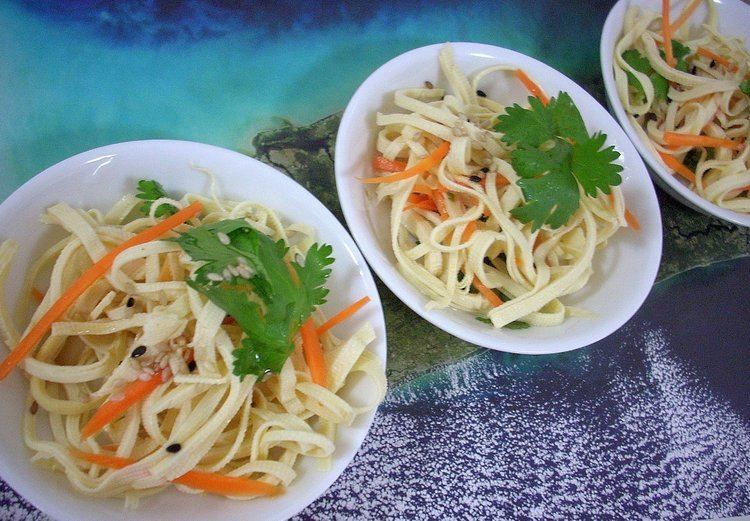Alternative names Tofu skin Place of origin China | Course Jiangsu cuisine | |
 | ||
Similar Beanfeast, Kinema, Mamenori, Soy nut, Suanla chaoshou | ||
Bai ye (English: tofu skin, Chinese: 百页, pinyin: bái yè) is a main ingredient of some traditional Chinese dishs, such as bean curd skin roll (Chinese:百页包, pinyin: bái yè bāo; literally "Hundred Pages Bun") that is widely known in southern regions of China and some of north regions of China and bean curd knot(Chinese:百页结). Tofu skin is a kind of pressed tofu. In China, pressed tofu comes in myriad shapes, sizes, and texture. Producer put a lot of pressure on the bean curds and they become tofu skin (bai ye).
Contents
Varieties
There are a number of cooking styles for bean curd skin. The two common styles are tofu skin roll and tofu knot.
Tofu skin roll (Chinese: 百页包)
Tofu skin roll is a common way of cooking bean curd skin. When served, it is made of a cylindrical tofu skin roll on the outside and vegetables and meat on the inside. The fillings range from vegetable, to pork or beef. Additional ingredients such as salt, sugar, and vegetable oil may be added. Generally, this dish is served with wheat gluten in a soup setting.
Tofu skin knot (Chinese: 百页结)
Tofu skin knot is a knotted strip of tofu skin. It is also the main ingredient of Shanghai-Style Red-braised Pork Belly(Hong Shao Rou ). Shanghai-Style Red-braised Pork is a slow stew of pork belly with tofu skin knots that are seasoned sugar, soy sauce, Chinese wine and spices. The tofu skin knot in this dish will soak up the sauce and become delicious.
"To make it go further, add more stock or water and a vegetarian ingredient that will soak up the sauce most deliciously. Puffy, deep-fried tofu is a fine addition to red-braised pork, as are hard-boiled eggs, dried tofu "bamboo" and the little knotted strips of dried tofu skin that can be found in some Chinese supermarkets (the latter two should first be soaked in hot water until supple)."
